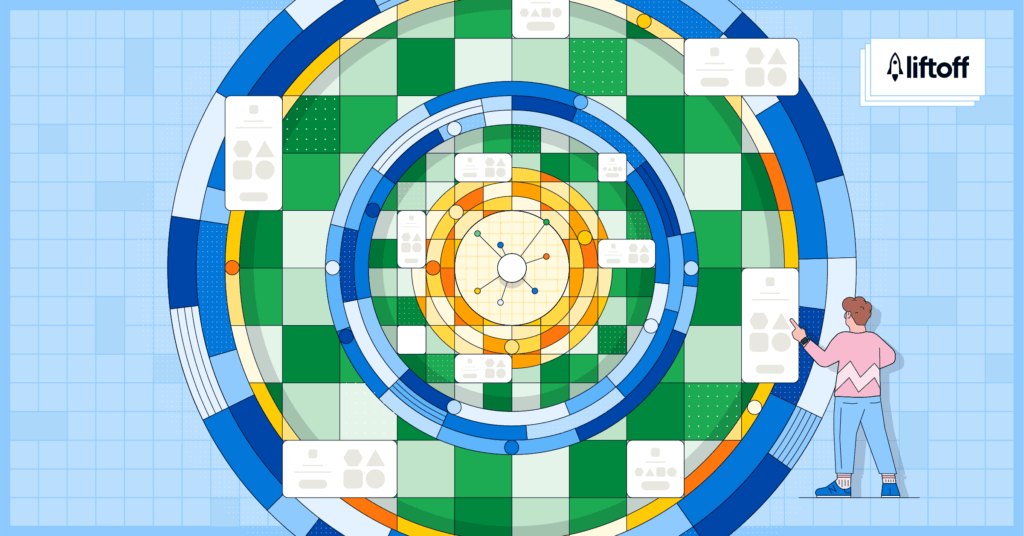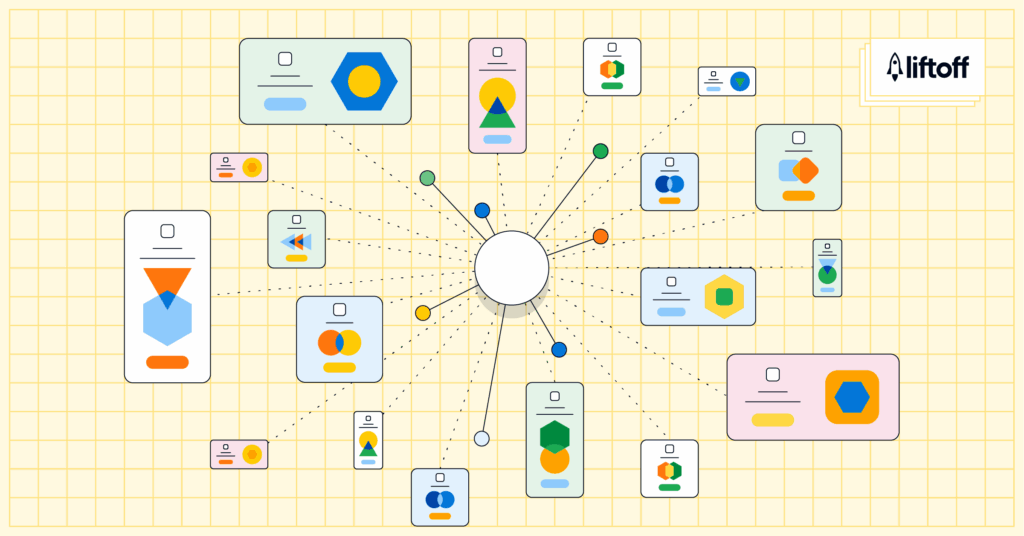
Webinar Recap | Proven Strategies to Supercharge Your Ad Creatives and Boost ROAS
In 2025, the competition for new users is fierce, and the quality of your ad creative can make or break your carefully optimized campaign. So what makes ad creatives successful? How can you match the right assets with the right ad formats? And, if you’re looking to scale at speed, which AI tools and workflows can expand your resources without sacrificing the quality of your ads?
Liftoff’s Senior Manager of Creative Performance, Deanna Ulrich, recently joined a panel of experts from companies including TikTok and Singular to discuss what today’s top marketers are doing to drive success. You can watch the full webinar here, and check out the highlights below.
Invest in Creative Research and Cross-Team Collaboration
Plenty of factors underpin creative performance, from the strength of your data and targeting to the ad formats you choose, to where your ads are placed. With all this in mind, the panel shared some of their top tips on how to maximize your ROAS.
You have many options for your ad creatives, and competitor analysis is a great place to start. Look at what types of creative competitors are running, how long their ads run for, and what impressions their ad campaigns pick up. Don’t limit yourself by focusing on direct competitors. Ads from adjacent industries—or even a completely different app vertical—can provide the inspiration you need for your next campaign.
Lisi Gardiner, product director at Singular, suggests weekly hands-on meetings where multiple teams watch different ad creatives: “I think that [regular syncs] are a really important part of the process, keeping in tune with the market and understanding what’s happening.”
An effective way to speed up the ideation process is to create open communication channels across your teams. This includes your monetization teams, creative design teams, and product managers, all of whom will have different ideas about new concepts and how to iterate.
“We’ve learned that we really need to be approaching solutions with multiple perspectives,” says Liftoff’s Deanna Ulrich. “We’re really leaning into cross-functional performance pods. Instead of these siloed workflows, we need a holistic view of performance end-to-end.”
At Liftoff, this brainstorming process involves four different teams. A creative strategy team translates campaign goals into testable value props, isolating specific assets or formats that need to be tested. This ensures Liftoff can produce high-quality content at scale with the assistance of AI tools. Liftoff’s Operations team provides more data-focused feedback loops, isolating inventory-focused ad management and flagging any opportunities. Finally, product teams ensure everything stays on track with constant testing and reporting so ads can be quickly iterated or scaled.
Unifying tools and simplifying reporting methods are also great ways to keep everyone on track since different departments often have their own ways of working. “Being able to automate the tracking and distribute those creative learnings efficiently keeps all of us informed,” Ulrich says. Ultimately, this all comes down to communication and teamwork.
Targeting the Right Audience With the Right Message
Of course, it doesn’t matter how good your creative is if they don’t reach your target audience. With tools like Symphony Creative Studio, creative teams can easily adapt content for target audiences and localize assets as needed. Overall, it’s just important to know the personas of your target audiences and what prompts engagement. Consider the following:
- Who are you targeting?
- What are you going to do to engage them?
- When will you target them?
- Where is your audience spending their time, and how will that determine where you target them?
Phillip Levin, Creative Director at CRAFTSMAN+, says the first place to start is with research. Competitor analysis is also essential here, as it can help teams align on the user motivations of your target audiences and on the KPIs that measure success. This is where you can also put your first-party data to the test, as it can be used to carve out target personas and guide the creatives you’re developing.
“You have to have a good understanding of the channels where you’re running [ads] and all the data that you have from [your channels] to be able to build relevant creatives that are targeting that audience,” adds Singular’s Lisi Gardiner.
With your research sorted, it’s time to choose your ad formats. Of course, there’s plenty of research out there showing which ad formats can deliver the best ROAS, but you’ll also want to consider which ad formats your target audience responds to and the goals of your campaign. If you’re looking to grow installs, playable and interactive end cards are an effective way of driving conversions—since they give customers a taste of what to expect from your product.
Equally important is your messaging, which should be tailored to your audience segment and refined through repeated A/B testing. To avoid overwhelming audiences and to keep ads memorable, Levin likes to stick with one key message per ad.
“I like to think of it like a song, where you might not remember all the lyrics of a song, but you might remember the chorus or just a couple of words here and there,” he says.
Finding Success With Creative Testing
Brett Hastie, associate director of performance creative at Tinuiti, highlights the many variables driving the testing process that require unique approaches specific to your clients’ or ad campaign’s requirements.
At Tinuiti, creative testing is divided into performance buckets. Each bucket is tailored to specific campaign objectives that change from client to client. This allows the team to dig deeper into more granular ad components, such as messaging, brand messaging, and imagery.
“When starting from a clear narrative, it’s easier to generate variations and be able to pressure test them in market,” Hastie says.
Testing matrices are also a great way to map what you want to test. The results can be used to refine a creative concept and answer specific performance questions.
“So maybe we start with a static or an HTML banner to set the messaging. From there, we can create videos to show more of the product. Then we can pair winning videos with playable or interactive end cards to get people to interact with your product. And then maybe we can even sprinkle in a static for retargeting purposes, which can create a winning combination for us,” says Phillip Levin from CRAFTSMAN+.
Using AI to Improve Creative Strategy and Drive Better Performance
AI is here to stay, and new platforms are constantly emerging and evolving. AI-enabled technologies and platforms help advertisers engage quality users at scale by taking the guesswork out of campaign optimization. But with so many AI tools, which are especially effective at improving creative strategy and driving ad performance?
Singular’s Lisi Gardiner points out that one of the biggest challenges is determining why AI tools are practical. They are excellent at optimizing campaigns and delivering the results you need at scale, but this level of scale can sometimes mean you’re left in the dark when it comes to breaking down. It’s hard to determine which specific campaign components have resulted in its success.
That’s where tagging comes in, ensuring campaigns carry all the attribution data needed to understand installs and post-install events. “You also need to have your top funnel and your cost data from the network. [At Singular], we automatically tag all your creatives using AI, and then we can combine it with the data and the reporting we already have.”
Platforms such as TikTok are also expanding to offer a broad range of AI tools for campaign optimization. Dina Kirsher, global product marketing manager of TikTok’s Symphony Creative Studio, says AI is great for localizing campaigns with dubbing and lip syncing across different languages and can also supercharge creative assets.
This is where generative AI tools such as ChatGPT and Microsoft Copilot can be used, the former for image generation and the latter for research and ideation. At CRAFTSMAN+, these generated assets are fine-tuned with audio enhancements, image resizing, and caption additions in traditional design programs such as Photoshop and Premiere Pro.
Of course, QA processes are an important part of maintaining ad quality. “I know sometimes if you generate an image of a hand, for example, the number of fingers will be different. There are small details that will be off. So always QA your output,” Levin explains.
Examples of Winning Creatives
Often, small, strategic edits to ad creative can make the biggest difference. TikTok’s Kirshner gives an example of a client who had a top-performing ad that was 27 seconds long. Kirshner worked with the client to reduce the ad to 14 seconds while adding a new text hook, emojis, and tweaking the font size. The latest version of the ad massively outperformed the original—and all it took was a few minor changes to what was already a successful ad.
Liftoff’s Deanna Ulrich has seen similar results by tweaking formats for a client in the sports betting category, where the creative was showing real-time games via an API and feed. “We usually see a higher performance in the interstitial format, but we tried this in the banner format. Banner can be an underperforming format, but when we introduced this, ITA jumped from 4% to 20%,” she says.
On the topic of ad formats, Ulrich highlights another example showcasing the ROAS of more modular ad formats. Liftoff’s ad selector gives users more control over their ad experience, with carousels allowing them to swipe through multiple playables or videos to choose from, enhancing engagement.
It’s important to remember that playables aren’t just useful for gaming apps. According to Levin, they’re also an excellent format for brands since they’re really effective at grabbing users’ attention. “It drives engagement, it creates a stronger connection to your brand because it allows users to interact with your brand before they download it or look at the product more closely,” he says.
An example is an ad for McDonald’s where users swipe the bottom of their screen to move a burger bun from side to side and catch ingredients in a timed playable. Once the playable section ends, a video ad plays before finishing with an end card where the user can take an action.
Looking to learn more about optimizing your ad creative? You can watch the full webinar here.

